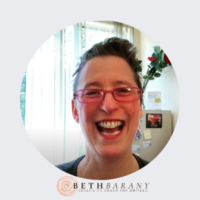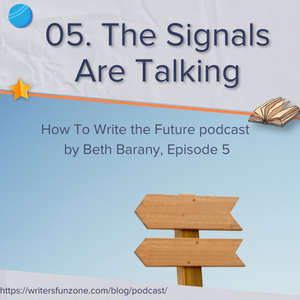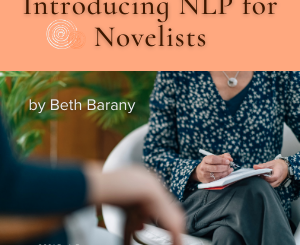The Signals Are Talking
In todays latest episode of “How To write The Future” titled “The Signals Are Talking” I talk about pattern recognition from the fringes and Amy Webb’s six-step methodology process.
Have a listen to the episode here: Apple Podcasts | Google Podcasts | Spotify | Buzzsprout | Amazon Music | Podcast Addict | Podchaser| Youtube
 Beth Barany is an award-winning novelist, master neurolinguistic programming practitioner, and certified creativity coach for writers, including being a workshop leader & keynote speaker. Beth has published books in several genres including young adult fantasy, paranormal romance, and science fiction mystery.
Beth Barany is an award-winning novelist, master neurolinguistic programming practitioner, and certified creativity coach for writers, including being a workshop leader & keynote speaker. Beth has published books in several genres including young adult fantasy, paranormal romance, and science fiction mystery.
Learn more about Beth Barany at these sites:
Author site / Coaching site / School of Fiction / Writer’s Fun Zone blog
RESOURCES
Amy Webb, The Signals Are Talking: https://books2read.com/thesignalsaretalkingwebb ;
and her organization: Future Today Institute: https://futuretodayinstitute.com/
SCIENCE DAILY: https://www.sciencedaily.com/news/
TALK TO A WRITING COACH https://writersfunzone.com/blog/talk-to-a-writing-coach/
SHOW NOTES
“What about the future are you trying to determine? Is it a specific kind of technology? A cultural behavioral pattern? A system of running companies? A way of feeding people? Language evolution? Where in society today are people asking the hard questions or making some new discoveries?”
In high school, I would spend every week reading Omni magazine in the school library. Today I often read Science Daily. Both of these sources of information play huge inspirations into the questions I ask about the future.
In this episode I talk about Amy Webb’s book (that shares the same name as the title of this episode) and delve into her six-step methodology, offering my viewpoint for each step. I use my own Janey McCallister sci-fi mystery novels as an example and some of the decision making process for that series.
In this episode, you will learn the following:
1) Where do you look for inspiration in writing the future?
2) What are you trying to determine about the future?
3) How can Amy Webb’s six-step methodology help your writing?
ABOUT HOW TO WRITE THE FUTURE
The How To Write The Future podcast is for science fiction and fantasy writers who want to write positive futures and successfully bring those stories out into the marketplace. Hosted by Beth Barany, science fiction novelist and creativity coach for writers.
Tips for fiction writers!
This podcast is for you if you have questions like:
- How do I create a believable world for my science fiction story?
- How do figure what’s not working if my story feels flat?
- How do I make my story more interesting and alive?
This podcast is for readers too if you’re at all curious about the future of humanity.
TRANSCRIPT for 05. The Signals Are Talking
When I was a teenager, I would spend time every week reading Omni magazine in the school library. I loved that magazine. It was always talking about new technologies and also had very imaginative stories in it.
That definitely was one of my early influences.
Hi everyone. I’m Beth Barany. I run How To Write The Future podcast for science fiction writers who want to write positive futures and bring those stories successfully out into the marketplace.
Today. I want to talk about The Signals Are Talking. This is the title of Amy Webb’s book with the subtitle, Why Today’s Fringe is Tomorrow’s Mainstream.
I highly recommend you read this book, and I will be using this book as inspiration to talk about how you can write the future.
Specifically, today I’m going to talk about pattern recognition from the fringes. If you are trying to determine the future of a particular aspect of your story world, but you don’t know what it needs to be for your story, and it’s pretty wide open. You’ve made some assumptions, maybe about your story.
I’m going to use my story as an example. I decided to have a space elevator and have that go up to a space station.
When I was initially making these decisions in my Janey McCallister Mystery series, it’s a sci-fi mystery, I asked myself what technology would allow that space station and the space elevator to be built.
I was trying to figure out all the different moving parts of building a space elevator. I started researching directly and indirectly space elevators. Because I’ve read Amy Webb’s book, The Signals Are Talking, I knew that I needed to look at the fringes of society, and people building technologies, and I needed to find some patterns here.
Amy’s book really helped me pay attention to what’s happening in scientific laboratories. I decided if I’m building a world that has advanced technology, a hundred years in the future, I needed to understand what technologies were being built today, so I could speculate out what they could be in a hundred years.
Through the course of this research, I learned that what people are working on in laboratories today doesn’t even make it to the marketplace for maybe another 10 years or 20 years or 30 years, and won’t even be commonplace, for who knows, maybe 50 years.
So if something is just being discovered today, I could totally make it be a commonplace reality in my story set a hundred years from now.
This was the premise I was working on as I was doing my research. I wanted to find out what are the signals today so that I could find some patterns that I, as a creative writer, could put into my story world.
Now it’s your turn.
What are you trying to determine the future about? Is it a specific kind of technology? A cultural behavioral pattern? A system of running companies? A way of feeding people? Language evolution? Where in society today are people asking the hard questions, are people making some new discoveries?
What’s interesting is mainstream media does not report on these new discoveries. So think about the scientists or radical thinkers, or artists who are playing in the space.
Go pay attention to them. Search on YouTube; search on Google. Any other search engine. Search inside of networks that you may already know or be indirectly connected to. Ask people: do you know anything about X?
Let me take another example.
I am very interested in fog catchers or dew catchers, and I’ve been doing research on this for quite some time. Every once in a while, I’ll do a deep dive research, and I will watch videos and read articles on the topic and discover who is in the space and what are people doing. I will hear of experiments that engineers are doing in Germany or in Sub-Saharan Africa or in the Middle East. I will hear of vodka company here in California that has been catching the fog and using it to distill and make vodka.
Where can you go to find people working maybe on the fringes of society that is not published in mainstream media?
Can you talk to those people? Read those articles. Watch those interviews.
Notice that inspiration is coming from places that aren’t naturally making headlines.
I highly recommend that you check out Amy Webb’s book. She has lots of methodology and processes that I will be revisiting going forward. She has an entire forecasting methodology.
It’s a six step funnel.
In this second half of today’s episode, I will go into Amy Webb’s six step methodology.
Step one is the fringe. Make observations and harness information from the fringes of society or a particular research area.
I have subscribed to Science Daily. And I get these daily digests of all kinds of scientific discoveries coming out of research laboratories around the world. It’s fascinating. Every single day I practically fall off my chair because I cannot believe that I’ve made that discovery. It’s incredible. What can I do with that as a creative writer as someone writing science fiction? I am super inspired right away. My brain goes: what if…?
What if this was an everyday thing? What if everybody could have fog catchers and dew catchers? Even in the driest locations. And use temperature differentials to get their water. Then California wouldn’t have to suffer in a drought. What if that technology was readily available and easy for anyone to create out of a kit that they can put on a patio or a backyard or even a rooftop? Wouldn’t that be cool? So I have that in my imagination and I’m looking for a place to put it in my stories.
Step two in this forecasting methodology that Amy Webb puts forth she calls Cipher. Uncover hidden patterns by categorizing information from the fringe. Contradictions, inflections, practices, hacks, extremes, rarities.
We’ll notice another big theme in my stories is what they call biohacking. In my story, it’s pretty normalized that people might have brain computer interfaces. And in fact, my main character has an ocular implant in her eye due to an accident when she was a teenager.
Many teens in her location, I’ve decided, had pretty mundane implants that would allow them to have more senses in a certain area. In her case, she has a visual acuity, unlike most people.
I spent a lot of time thinking about this, researching about the current technology on brain computer interfaces, as well as how the eye actually works and what her implant can do and cannot do.
So if you’re working on any area of augmentation, for example, biohacking, pay attention to what people are doing today. It’s quite amazing.
I spent time researching this, hearing what people were doing, finding some companies that sell interesting body implants that allow people, for example, to know north, south, east and west. That’s a real thing that exists today.
Watching what people are doing on the fringes allows our imagination to expand upon that.
Step three, ask the right questions.
Ask the right questions to determine whether a pattern is really a trend. In her book. The Signals Are Talking, she goes into discussing what those questions are.
Step four. Calculate the ETA — estimated time of arrival. This is for people who are trying to do some near term forecasting in terms of implementing things in their organization.
So she says, ensure that the timing is right for the trend and for your organization. Because companies want to be right on time. They don’t want to be too early or too late. They have their own mandates to worry about.
Now us as science fiction writers, I use this because I’m setting a story a hundred years out. I am trying to find out what could be. Not necessarily what is today. If you’re writing a story that is much further out, you have a lot more leeway.
Her step five in her six-step funnel is to write scenarios. And this is where we come in as science fiction writers. Scenarios inform the strategy you will create to take the necessary action on a trend.
If you’re working with an organization and you want to write scenarios for them, this is going to be really important to their current decision-making. But as science fiction writers, we could take this step and use it to play with positive futures, what-if scenarios.
If we want to create a world in which fog catchers and dew catchers are normal, well, let’s write a story like that and help people envision what it would be like to be able to capture their own water and create water regeneration cycles and how every household could have one. What might that look like? And then that has real world implications today. People today might start asking, well, yeah, how come we don’t have that? I could put into the story the systemic changes that would have to happen for everyone to be able to have a fog catcher.
Step six of her six-step funnel: Pressure test the future. Are your scenarios comprehensive enough? Is your level of confidence justified? Is the strategy you’re taking the right one for the future? And again, this is for companies and organizations who are thinking about implementation.
For us, we can maybe write the scenario that we want, the positive future. Everyone can catch their own water. And then I would also probably write a story in which how it came about that everyone was able to catch their own water in California.
That’s what this step makes me think about. If I wanted to write a convincing story, I would also need to know the backstory of how this positive future came about.
Her final step is to predict in a global sense, what is the future of that technology and to be able to describe it in a convincing manner.
I really appreciate Amy Webb’s forecasting methodology. It helps me as a science fiction writer and it can help you. I encourage you to check out her book. A link to it is in the show notes.
As a writer and a writing teacher, I really take inspiration from that and I think about: how can you apply it? How can I apply it?
So I hope you can take this material and make it your own and apply it to your story creation.
What signals do you want to be paying attention to so that you can get information input? So that you can sit down and make some decisions about the story that you’re working on.
if you want to stay in touch, follow me on LinkedIn and Twitter @BethBarany or you can write me beth@bethbarany.com.
Well, that’s all for this week. Everyone, write long and prosper.
Loved this episode? Leave us a review and rating here: https://www.buzzsprout.com/2012061
or in your podcast home of choice.
***
Connect with Beth Barany
***
EDITED WITH DESCRIPT
https://www.descript.com?lmref=_w1WCA
MUSIC CREDITS
Music from Uppbeat (free for Creators!): https://uppbeat.io/t/soundroll/fuzz-buzz
License code: UMMKDRL02DFGKJ0L. “Fuzz buzz” by Soundroll.
Commercial license: https://musicvine.com/track/soundroll/fuzz-buzz
PRODUCTION BY Beth Barany
SHOW NOTES SUPPORT from Kerry-Ann McDade
Distributed by Buzzsprout: https://www.buzzsprout.com/?referrer_id=1994465 (referral code)
***
For more “How To Write the Future” episodes, go here.
If you’d like to invite Beth onto your podcast, drop her a note here.




